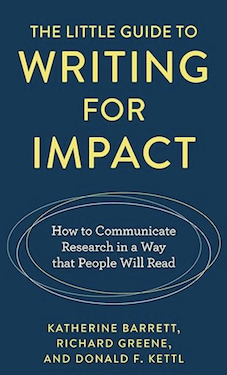
The Little Guide to Writing for Impact

As long ago as 2010, the federal government’s Plain Writing Act required that all federal agencies write "clear government communication that the public can understand and use."
Since then the Center for Plain Language has issued an agency by agency report card to measure how successful this mandate has been by examining the quality of writing. Last January, the Departments of Justice, Housing and Urban Development, Commerce, Defense, Treasury as well as the Securities and Exchange Commission all got Fs. Only two agencies, the Department of Agriculture and the Social Security Administration got As. Hardly the kind of report card you’d want to bring home to Mom or Dad—or the reports that you’d want Mom and Dad to try to read.
State governments have also tried hard to get their employees to write well. Just last November, Washington Governor Jay Inslee signed an executive order that mandated that “all executive cabinet and small cabinet agencies create and adopt a plain language policy that identifies how the agency will incorporate or strengthen plain language writing and design principles and practices.”
It's certainly important that government officials write well. But the three of us are even more worried about a connected issue: too many people with great academic training are writing about powerful ideas, backed by years of research, that are obscure at best and incomprehensible at worst.
To nudge solutions forward, we’re just published a short book, The Little Gude to Writing for Impact (Rowman and Littlefield, 2024). It’s aimed at people with big ideas who want people to read them. It’s handy for writers of everything from short blog posts to op-eds, from commentaries to policy briefs, and for dissertations, articles for the popular press, academic journals, and books.
Our little book, we think, will help a wide range of writers:
- University-based academics whose work intersects with public administration and policy and who want to communicate the results of their research clearly.
- Researchers at academically-oriented think tanks and foundations who want to make an impact with what they write.
- Researchers writing for the all-important journals who want to elevate their standing in the community.
- Students —both at graduate and undergraduate levels – who are preparing for careers in research and public service, as well as those enrolled in public policy courses.
- Academically trained authors of policy briefs and other documents including legislative staffers and anyone intent on communicating big ideas to busy policy makers.
- Mid-career professionals who want to advance their careers by winning public attention for their pragmatic insights.
As we write in the introduction, “People trained in academic writing . . . have an enormous quantity of potentially powerful information to share. But if their work doesn’t find its way to the people who can champion or implement programs and policies it may bring as little value to the world as a caterpillar that placidly eats leaves but never turns into a butterfly.”
The only thing worse than trying to sell a bad idea is having a great idea the writer can’t sell and are hoping to help writers steer around potholes like:
- Fancying up language with words of many syllables that only muddy the message.
- Starting with multiple meandering paragraphs that make readers want to go find something else to read.
- Allowing inaccuracies to creep into prose, largely through laziness
- Showing contempt for reader’s valuable time by taking twice as long as necessary to finish a thought.
- Turning multiple thoughts into over-long paragraphs that leave readers gasping for air.
The book presents a series of guidelines that will enable readers to successfully frame a policy argument; pitch it to editors; organize the work so that the ideas have real impact; support it with data and stories; find the right publisher; and follow up after publication to ensure that the argument has enduring impact.
We even tried to make it funny, where we could. The book is short and easily navigable throughout.
People we deeply respect have reinforced the importance of our message.
For example, Donna Shalala, Interim President of The New School and former secretary of the U.S. Department of Health and Human Services, commented that the book is “A little book that will have a big impact on policy. Imagine a whole generation who can clearly communicate great ideas!"
Katherine Willoughby, editor-in-chief of Public Administration Review and Golembiewski Professor of Public Administration at the University of Georgia was equally kind in her comment that “If you want to author a classic book, have your research published in a premier academic journal, complete an award-winning dissertation, or simply write better, consult The Little Guide to Writing for Impact. This quick read is chock-full of golden nuggets that, if engaged, will boost your influence on people and policy through your writing.”
One more (we’re enjoying ourselves here!). Chris Morrill, Executive Director of the Government Finance Officers Association, commented that “With notes of Strunk and White’s Elements of Style, Barrett, Greene, and Kettl have gifted us a highly practical guide for communicating in a hyper-distracted world. Even with an array of new digital tools and artificial intelligence, at core communicating involves crafting a clear, concise, and compelling message. Barrett, Greene, and Kettl gives us the tools to do so.”
Intrigued?
Readers of the IBM Center of Government blogs are being offered a limited-time special to purchase the book at a 30% discount. Just click here and after registering to make a purchase enter the code: WF130.
Alternatively, the book is also available on Amazon.com, in hard cover, soft cover, and Kindle versions.
Join the party! And let us know what you think.



